Raheel Ahmad, History Department UK
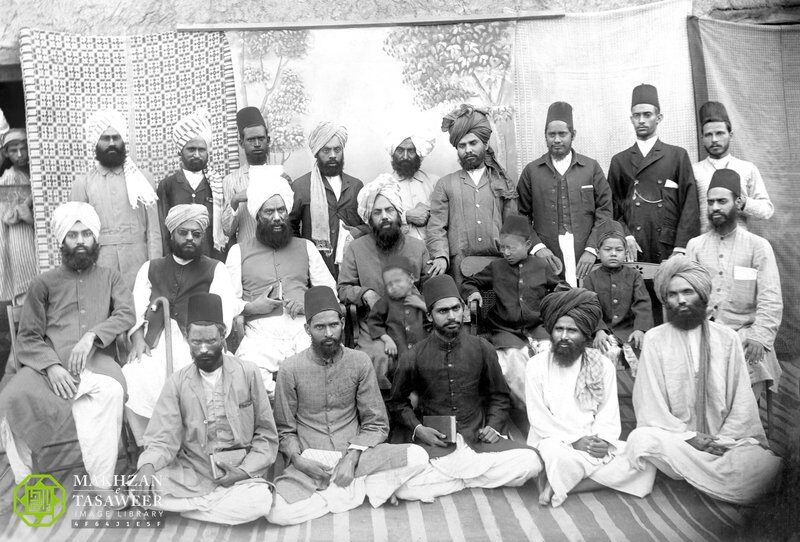
Hazrat Mirza Ghulam Ahmad, the Promised Messiahas published, preached and sent his claim of being the Reformer of the Age far and wide. He sent 8000 copies of registered letters in English to the religious leaders, rulers, scholars, judges and thinkers of Asia, Europe, and America, informing them of his claim in 1885 and inviting them to come and witness the truthfulness of Islam at Qadian. This number exceeded 20,000 in 1891 when he published his book Fath-e-Islam. (The Victory of Islam, p. 13)
Hazrat Ahmadas assured that if a sign was not witnessed within a year, a sum of 200 rupees per month, (two thousand four hundred rupees for a year) would be paid as compensation to such an individual. (Majmua Ishtiharat, Vol. 1, pp. 20-22)
Mr Charles Bradlaugh, an English political activist known for his relentless atheism, who founded the National Secular Society in 1866, was among the recipients of this announcement and invitation. At the time of receiving this invitation, he was serving as the liberal MP for Northampton, UK.
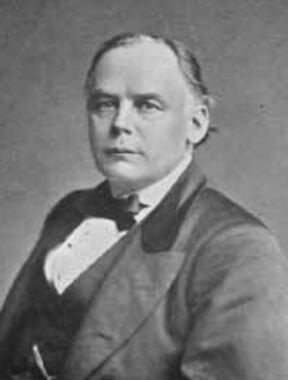
The Cork Constitution of 8 June 1885, reporting on the invitation he received from the Promised Messiahas, wrote:
“Mr Bradlaugh has received a curious invitation, which many people will probably hope he may accept, Mirza Gulam Ahmad who says that he has been commissioned by the Almighty, has sent the junior member for Northampton by registered letter an invitation to visit the Punjab, there to be converted to Islamism, and he offers to guarantee Mr Bradlaugh 200 rupees per month with food and lodging. Mr Bradlaugh has the invitation under his serious consideration.”
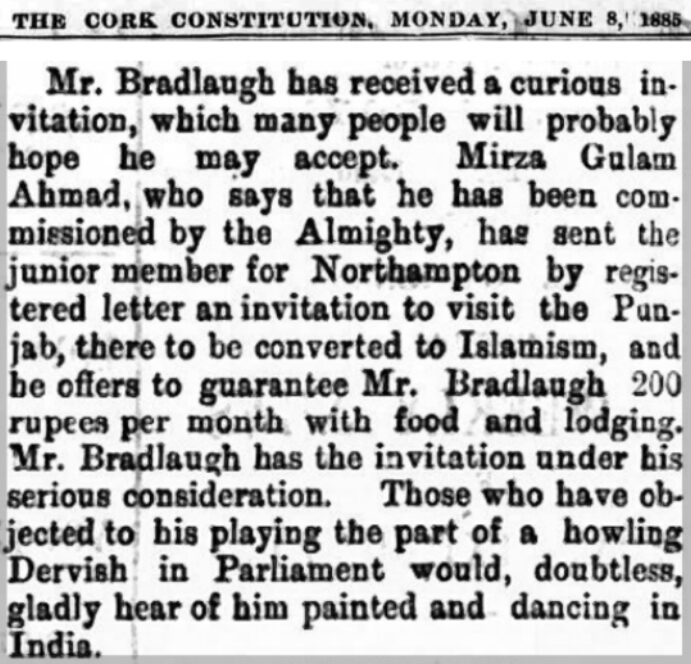
Another prominent member who was fortunate to receive this invitation was Henry Steel Olcott – a founding member of the Theosophical Society and its first president until he died in 1907. He received the two circulars from the Promised Messiahas regarding his book Barahin-e-Ahmadiyya and his claim to be the Reformer of the Age which Olcott reprinted in the September issue of his journal The Theosophist in 1886.

The Promised Messiahas in these circulars explained that his book Barahin-e-Ahmadiyya elaborated on the divine origin of the Holy Quran and the truthfulness of the Holy Prophet Muhammadsa, thereby demonstrating the superiority of Islam over all other faiths with logical arguments.
The Promised Messiahas offered 10,000 rupees to anyone who would prove the arguments brought forward therein to be false. All were invited to stay in Qadian at the expense of the Promised Messiahas.
The Promised Messiahas announced (as published by The Theosophist):
“Now, if you do not come [here], you will, yourself, be answerable to God. After awaiting your arrival for three months, the statement of your indifference will, ipso facto, be noted in the book as stated above, but in case you do come, and fail to behold any heavenly signs during your stay with me for the time specified, you shall be paid Rs. 200 per mensem (besides food and accommodation), which will be supplied free to all) as compensation to cover your damages, or as a recovery of fine in default of my promise. If you deem this sum inadequate to your dignity, I am even ready to pay as damages or fine for unfulfilling promise, whatever suitable sum you propose yourself, proportionate to your rank, if it be but not beyond my means.”
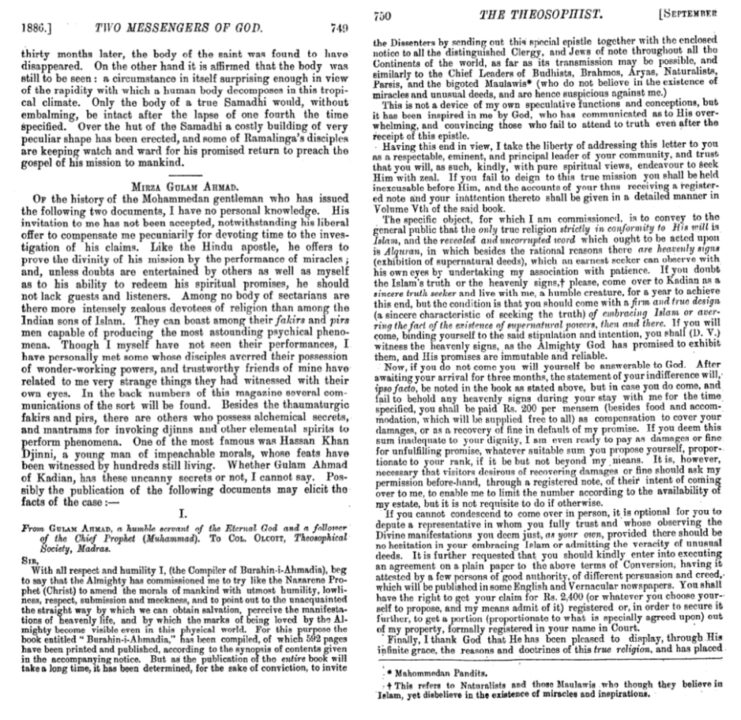
Olcott, however, indicated he could not go to Qadian. Firstly, as a theosophist, he fundamentally could not accept only one religion and one religious text contained the true path to God. Secondly, he was unwilling to adhere to the condition that a sincere seeker after the truth who had observed heavenly signs would need to either embrace Islam or at least proclaim the existence of supernatural powers. This may have appeared as a strange proposal especially when the followers of all faiths based their beliefs on tales and stories of the past as opposed to a direct experience.
This effort of Hazrat Ahmadas did not go in vain, however. It is suggested that Alexander Russell Webb who is famously referred to as the earliest prominent Anglo-American Muslim convert, was at the time an active theosophist and as a keen reader, may perhaps have read about the invitation of the Promised Messiahas in The Theosophist.
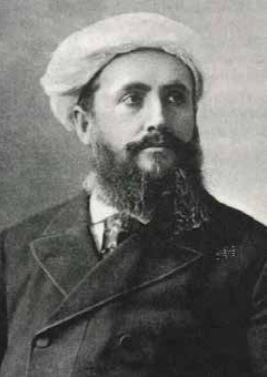
The mention of these circulars in Olcott’s journal paved the way for Webb to initiate correspondence with the Promised Messiahas, the details of which were published by Hazrat Ahmadas in his book Shahna-e Haqq.
Brent D Singleton talking about the second circular of the Promised Messiahas which was also reprinted by Olcott, wrote:
“In 1886, he came across an advertisement by Mirza Ghulam Ahmad of Qadian, India, founder of the Ahmadiyya Movement, challenging anyone to find fault with even a single one of his 300 arguments in favour of the authenticity of the Qur’an and Muhammad’s prophetic mission. Until this time, Webb had given little attention to Islam, but now he was intrigued and wanted to learn more and thus started a correspondence with Ahmad.” (Minarets in Dixie: Proposals to Introduce Islam in the American South by Brent D Singleton, p. 1)
Patrick D Bowen in his book, A History of Conversion to Islam in the United States, Volume 1, White American Muslims before 1975 suggests that Webb, who was a keen reader of Theosophy-related writings while studying at the St Louis Theosophical Lodge, which was highly influenced by Thomas M Johnson, must have come across these Islam-related writings, yet the invitation of the Promised Messiahas that Webb had come across was “undoubtedly a major event in Webb’s religious life.” (Ibid, pp. 98-99)
He further writes:
“Indeed, the timing of the appearance of information about Ghulam Ahmad in the ts [Theosophical Society] relative to Johnson’s increased interest in Islam and Sufism is quite suggestive. Learning about Ahmad’s activities may have, therefore, been what motivated Johnson to create in March 1887 his own Islam-connected practical occult organization, the ‘Sufic Circle.’” (Ibid, p. 103)
Alexander Russell Webb initiated the correspondence with Hazrat Mirza Ghulam Ahmad, the Promised Messiahas after discovering the invitation of the Promised Messiahas in Olcott’s journal The Theosophist or in the newspaper The Scotsman. (Minarets in Dixie: Proposals to Introduce Islam in the American South by Brent D Singleton, p. 1)
This ismentioned in the Urdu synopsis of Webb’s first letter, found in the writings of the Promised Messiahas – Shahna-e-Haqq. Webb said he had seen the letter of the Promised Messiahas in an American newspaper in which the Promised Messiahas invited readers to a demonstration of the truth. This inspired Webb to write to him. Webb also said he had made an extensive study of Buddhism and Hinduism and had attempted to study the teachings of Zoroaster and Confucius. He had, however, only studied very little about the Holy Prophet Muhammadsa. Webb concluded that “He is sincerely in search of the truth.” (Ibid, p. 373)
Alexander Russell Webb in his second letter to the Promised Messiahas, wrote:
“I have no reason to doubt that you are inspired by God to spread the light of truth; therefore I would be happy to know more of your teachings and to hear further from you. God, who can read all hearts, knows that I am seeking for the truth that I am ready and eager to embrace it wherever I can find it. If you can lead me into its blessed light, you will find me not only a willing pupil but an anxious one.” (Ibid, p. 441)
In response to Webb’s second letter, the Promised Messiahas replied on 4 April 1887:
“I received your letter, dated 24 February 1887, which proved itself to be great delight to my heart and a satisfaction to my anxieties. The contents of the letter not only increased my love towards you that led me to the hope of a partial realisation of the object which I have in view for which I have dedicated the whole of my life viz, not to confine the spread of the light of truth to the oriental world but, as far as it lies in my power to further it in Europe, America, & Co. where the attention of the people has not been sufficiently attracted towards a proper understanding of the teachings of Islam.” (Shahna-e Haqq, Ruhani Khazain, Vol. 2, p. 443)
Umar F Abd-Allah in his book A Muslim in Victorian Britain: The Life of Alexander Russell Webb, talking of Webb’s correspondence with Hazrat Mirza Ghulam Ahmad, the Promised Messiahas, writes:
“One of Webb’s first steps toward Islam, however, occurred in St Louis and, insofar as we know, without direct connection to the Theosophical Society. Two years before his move to the Philippines, where he accepted Islam, Webb initiated a remarkable correspondence about Islam with the Indian Muslim scholar Mirza Ghulam Ahmad. Mirza Ahmad would soon become the object of great controversy, but that was not yet the case when Webb wrote him. At the time, Mirza Ahmad was recognized as one of the foremost Muslim scholars of India and was actively involved in making Islam known to the West, especially through personal correspondence with prominent Westerners. Webb came to know of Mirza Ghulam Ahmad’s interest in corresponding with persons interested in Islam and wrote a letter to him. The Webb–Mirza Ahmad letters are an essential part of Webb’s biography and are of great note because they were a prelude to Webb’s later correspondence with Indian Muslims and presaged many of his later concerns about Islam, even the possibility of creating an Islamic mission in America.” (A Muslim in Victorian America, The Life of Alexander Russel Webb p. 60)
Webb, after resigning from his post of Consular Representative of the United States at Manilla, visited India in 1892. Haji Abdullah Arab (a wealthy Memon merchant) played a pivotal role in his travel and other arrangements in India. He spent about four months in India touring and visiting Muslim leaders and delivering lectures to collect funds to start an Islamic mission in America.
The arrival of Webb in India happened to be at the time when the Promised Messiahas had announced (in 1891) his claim to be the second coming of the Messiah, which prompted great uproar and hostility towards him in India.
Therefore, Alexander Russel Webb was advised it would not be prudent to meet with the Promised Messiahas as the meeting would hurt their efforts to collect funds for establishing an Islamic mission in India.
Haji Abdullah Arab and Maulvi Hassan Ali, both of whom had advised against meeting the Promised Messiahas later accepted him and became his companions. Maulvi Hassan Ali later published a book, Taeed-e-Haq (Corroboration of the Truth) in which he narrated the entire account of Webb’s visit to India.
The Ahmadiyya records show that Haji Abdullah Arab who was in the allegiance of a saint known as Sahib-ul-Alam accepted the Promised Messiahas as a result of his saint’s Istikhara prayer about the truthfulness of the Promised Messiahas where the Holy Prophetsa himself informed this saint in a vision that Hazrat Ahmadas was true in his claim. (Maktubat-e-Ahmad, Vol. 2, p. 431)
Webb regretted his decision to not meet the Promised Messiahas and after his return to the USA, he frequently corresponded with Mufti Muhammad Sadiq Sahibra asking for the prayers of the Promised Messiahas. (Zikr-e-Habib, pp. 310-312) He shared details of many Westerners who had either converted to Islam or were interested in Islamic teachings. (Ibid, p. 74)
The Promised Messiahas wrote in The Victory of Islam:
“The second branch of this operation is the arrangement for the distribution of leaflets, which is underway through divine command for the purpose of Itmam-e-Hujjat [the Conclusive Argument]. Thus far, over 20,000 leaflets have been published – and will forever continue to be [published] in the future, during times of need – to fully convey Islamic arguments to the people of different faiths.” (The Victory of Islam, p. 13)
From Hazrat Ahmad’s invitation of Islam to the Empress, Queen Victoria, to his conveying the message of Islam to intellectual circles of Europe and America, it is clear that he established the foundation of the Ahmadiyya missionary foundation in the West, the fruits of which we especially began seeing during the era of the Second Manifestation (Khilafat-e-Ahmadiyya) when Ahmadi missionaries like Hazrat Fateh Muhammad Sayalra and Hazrat Mufti Muhammad Sadiqra were sent to preach Islam on the streets of Britain, Europe and America, described by Ron Geaves as “The first organized effort by Indian Muslims to establish Islam in Britain”. (Islam and Britain, p. 67)
We have a list of westerners who had either corresponded with the Promised Messiahas or came to meet him in person. Some of whom were fortunate and blessed to have accepted his claims, such as Mr Charles Francis (Muhammad Abdul Haqqra) (www.alhakam.org/charles-francis-sievwrights-meeting-with-the-promised-messiah-part-i/) who visited Qadian in October 1903, or Anthony George Baker (www.reviewofreligions.org/17280/the-first-ahmadi-muslim-convert-in-philadelphia/) whom the Promised Messiahas mentioned in his book Barahin-e-Ahmadiyya Part V, p. 132.


Good article